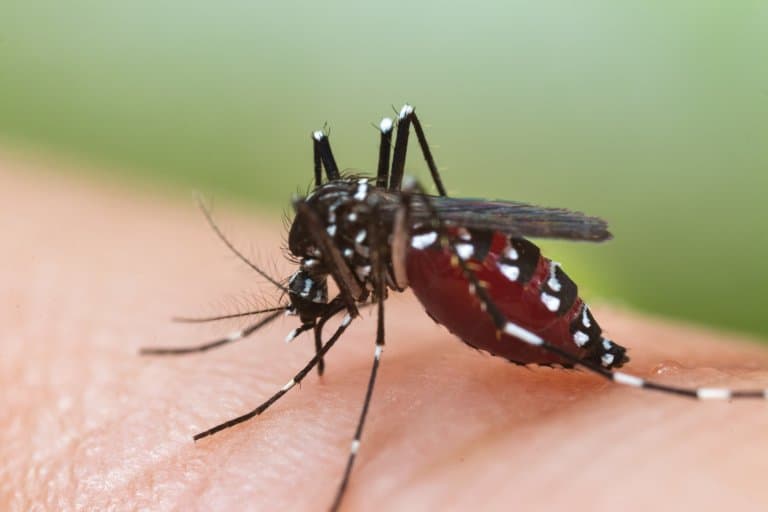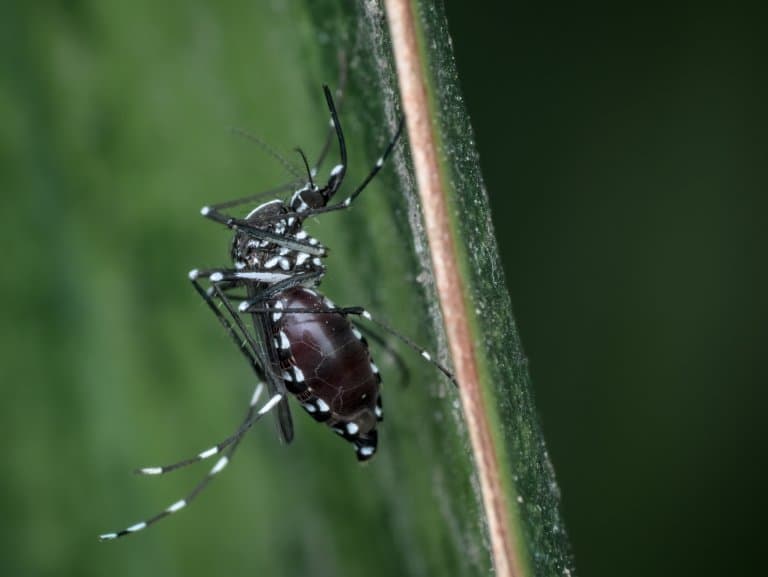Asian Tiger Mosquito Profile
Climate change is, of course, bringing increased flooding, food scarcity, landslides, soil depletion, droughts, pestilence, and lots of other nasty stuff that’s mostly affecting distant countries full of people without the internet.
But now that an invasive mosquito is bringing a minor chance of mild tropical infections to the rich hemisphere, well, now it’s just going a little too far.
The asian tiger mosquito, also known as the forest mosquito is a mosquito species native to the Southeast Asia tropics, with white bands on its body and legs.

Asian Tiger Mosquito Facts Overview
| Habitat: | Varied, widespread, tropical to temperate |
| Location: | Asia, Africa, Europe, the Americas |
| Lifespan: | 70 days as an adult |
| Size: | About 1cm (0.4 inches) long |
| Weight: | <1g |
| Color: | Black with white stripes |
| Diet: | Bacteria and organic debris as larvae, nectar as adults. Females drink blood to incubate their eggs. |
| Predators: | Flatworms, beetles, waterborne parasites |
| Top Speed: | Unknown |
| No. of Species: |
1 |
| Conservation Status: |
Not listed |
Mosquitos strike terror into Western societies by bringing nasty little itchy bumps that ruin our evening picnics. But lesser-known consequences of species like the tiger mosquito from Asia include parasitic and viral diseases that can seriously affect humans and their pets.
Like all mosquitos, its the female that is equipped with elongated proboscis that she uses to collect blood and feed her eggs. Males primarily diet on nectar of flowers (as do females, when not feeding her eggs), and do not bite.
They have a rapid bite and are extremely agile which makes swatting them challenging!
For Europeans and North Americans, Tiger mosquitos are a macabre mascot for changes coming to a warming world. For people in the tropics, they’re one of many ongoing threats to the health and productivity of society.
Interesting Asian Tiger Mosquito Facts
1. They can survive the Winter
One of the ways this mosquito can travel the globe so effectively is its ability to weather bad weather until Winter passes.
Both the eggs and the mature mosquitos can survive colder temperatures, including snow, than other tropical species, making them very comfortable when invading foreign lands. And they can bring a lot of misery in their wake. 1
2. They lay eggs near water, rather than in it
Unlike other mosquitos, the female will lay her eggs close to stagnant water, but not directly in the water. They are more likely to lay eggs near flowers, which is the males diet.
As both females and males have short flight ranges, this is also their breeding ground.

3. They transmit a lot of human diseases
The list of diseases this mosquito can carry is quite impressive. At least 22 human pathogens are associated with this animal. Mosquitos are the deadliest animal on earth today.
Starting with the most notorious, Dengue affects an astonishing 400,000,000 people every year. Only around 0.01% of these cases are fatal, which is a bit less than malaria, but the disease itself isn’t much fun.
Zika virus is a fun little disease that comes with fever, red eyes, and the usual tropical disease symptoms. It doesn’t kill many people, and usually clears up by itself, but can severely affect unborn babies in the womb if the mother gets it.
Yellow fever is another one, and this affects only 200,000 people each year. It has a very effective vaccine and thankfully so, since around 15% of people who catch it will progress to life-threatening severity and half of those will die. Liver damage, and bleeding in the mouth, nose, and eyes, are all exciting symptoms of severe infection.
Chikungunya is next on the list, and this kills about 1 in 1,000, usually frail people. If you survive it, you’re likely to become immune to a second infection and like Zika and dengue, it comes with the fever and body pains.
But viruses aren’t all this fly has in its arsenal. It also carries some parasitic organisms that can cause you and your pet some problems.
4. They can harm your dog too
One of these parasites is the heartworm, Dilofilaria which is a parasite of dogs and cats, as well as many other animals in the Carnivora order, like coyotes, weasels, foxes and sea lions.
These little worms get involved in the heart muscle and can affect blood flow, causing death in some cases, especially in cats.
Not satisfied with spreading menace to mammals, tiger mosquitos can even affect arthropods.

5. They even cause problems for insects
Wolbachia are intra-cellular, bacterial parasites and that means they’re small enough to bother a lot of the smallest animals around.
When parasites get into an animal, they often fiddle with the settings and end up changing the behaviour of the host.
This unsettling concept is known as host-altered behaviour, and it’s why mice infected with T. gondii stop fearing cat urine, or why a carpenter ant with an Ophiocordyceps fungus in its brain overcomes its instincts and leaves the colony to ultimately bite down on a piece of grass and explode in a shower of spores, spreading the parasite’s genes.
Wolbachia is a real tweaker, and affects various arthropod species, changing their behaviour to suit it.
But even one of the most prevalent arthropod infections does nothing but make this animal stronger. In the case of the Tiger mosquito, Wolbachia gives them a great deal. The parasite actually makes them more fecund, laying more eggs, and more often.
This makes the mosquito even more successful in breeding and in turn, spreads more of the parasite too. And despite being one of the most unpopular animals on the planet across the animal kingdom, they seem to be doing well for themselves. 2
6. They’re hugely successful
Like humans, these mosquitos have spread to almost all corners of the globe and outcompeted the locals. Originating in Southeast Asia, tiger mosquitos have spread to Africa, the Americas, and Europe and are now more widespread in the Pacific, and they’re doing very well.
They are aggressive biters, happy to fly around in both daytime and night and are the unwitting vectors of a number of arboviruses and parasites that affect humans and their livestock.
And now that the climate is becoming more palatable to tropical species, they’ve started moving North, into Europe and North America.
And this is what’s recently been frightening people, but they’ve actually been hanging around for a while. 3

7. They’ve been in Europe since the ‘70s
There are a few different dates of entry floating about online, but it’s fairly certain that by 1979 there were Asian tiger mosquitos in Albania, having come through Chinese imports. In 1990, they were found in Italy.
In the US their discovery goes back as far as 1985, and all three populations have expanded from their location. Europe has been home to these pests for decades, and though they appear to be moving steadily North, they’re hardly strangers to the continent. 4
8. France reacts with vigour
If the President of France so much farts the wrong note, the populace will likely respond by upturning cars and setting fire to everything. So, it’s hardly surprising that it’s France leading the charge with the panic in Europe.
In their defence, half of France is now thought to have populations of this mosquito, making them one of the hotspots and their spread is a legitimate health concern.
The collateral damage of fumigating part of a city to catch one species of mosquito doesn’t bear thinking about, but the French did it in Paris for the very first time, killing everything within 150m of the home of a person who’d picked up dengue while abroad.
This species is known to have a short range of less than 200m. People in the wider area were asked to stay in their homes.
The worry is that a tiger mosquito could bite this person, become a vector, and take over the world.
But is the fear justified? 5

9. They may or may not be a big deal, yet
The mosquito itself is not any more harmful than other species of mosquito that we know and love.
The problem comes from their ability to act as vectors for disease.
The more complex the life cycle, the harder it will be to find the right combination of vectors and the less likely those diseases are to spread.
Viruses aren’t so fussy, but with diseases like Zika and Yellow fever, transmission still requires the virus to be present for it to be spread, so the presence of the mosquito alone doesn’t mean much.
Zika has not been reported in the US since 2017.
It remains to be seen how deadly or even inconvenient these mozzies will become, and it’s likely that a combination of routine screenings, vaccines, and behavioural changes (mosquito nets, screen doors) will be enough to keep the risk at almost zero, at least for the time being.
But even if they’re not a serious threat, they likely are a harbinger of things to come. 6
10. Dragonflies are an excellent method of control
There’s various ways to control and supress the spread of mosquitos and breeding, such as reducing stagnant water (old roof gutters, tyres, containers etc), or ovitraps.
But another more natural controller are dragonflies. Dragonfly larvae will eat tiger mosquito larvae, and adult dragonflies will also catch adult mosquito while flying!
Asian Tiger Mosquito Fact-File Summary
Scientific Classification
| Kingdom: | Animalia |
| Phylum: | Arthropoda |
| Class: | Insecta |
| Order: | Diptera |
| Family: | Culicidae |
| Genus: | Aedes |
| Species Name: |
Aedes Albopictus |
Fact Sources & References
- OBERTO ROMI, FRANCESCO SEVERINI, LUCIANO TOMA (2006), “COLD ACCLIMATION AND OVERWINTERING OF FEMALE AEDES ALBOPICTUS IN ROMA“, J. of the American Mosquito Control Association.
- Zhiyong Xi 1 , Jeffry L Dean, Cynthia Khoo, Stephen L Dobson (2005), “Generation of a novel Wolbachia infection in Aedes albopictus (Asian tiger mosquito) via embryonic microinjection“, PubMed.
- Agence France-Presse (2023), “‘A first in Paris’: city fumigates for tiger mosquitoes as tropical pests spread, bringing disease“, The Guardian.
- Ruth Müller et al (2023), “RNA interference to combat the Asian tiger mosquito in Europe: A pathway from design of an innovative vector control tool to its application“, Science Direct.
- Natalie Huet & Lottie Limb (2023), “Disease-carrying mosquitoes are spreading through Europe: How can we protect ourselves?“, Euronews.
- Kayla Clarke (2023), “Asian tiger mosquitoes: What Michigan residents need to know about these aggressive biters“, Click on Detroit.
